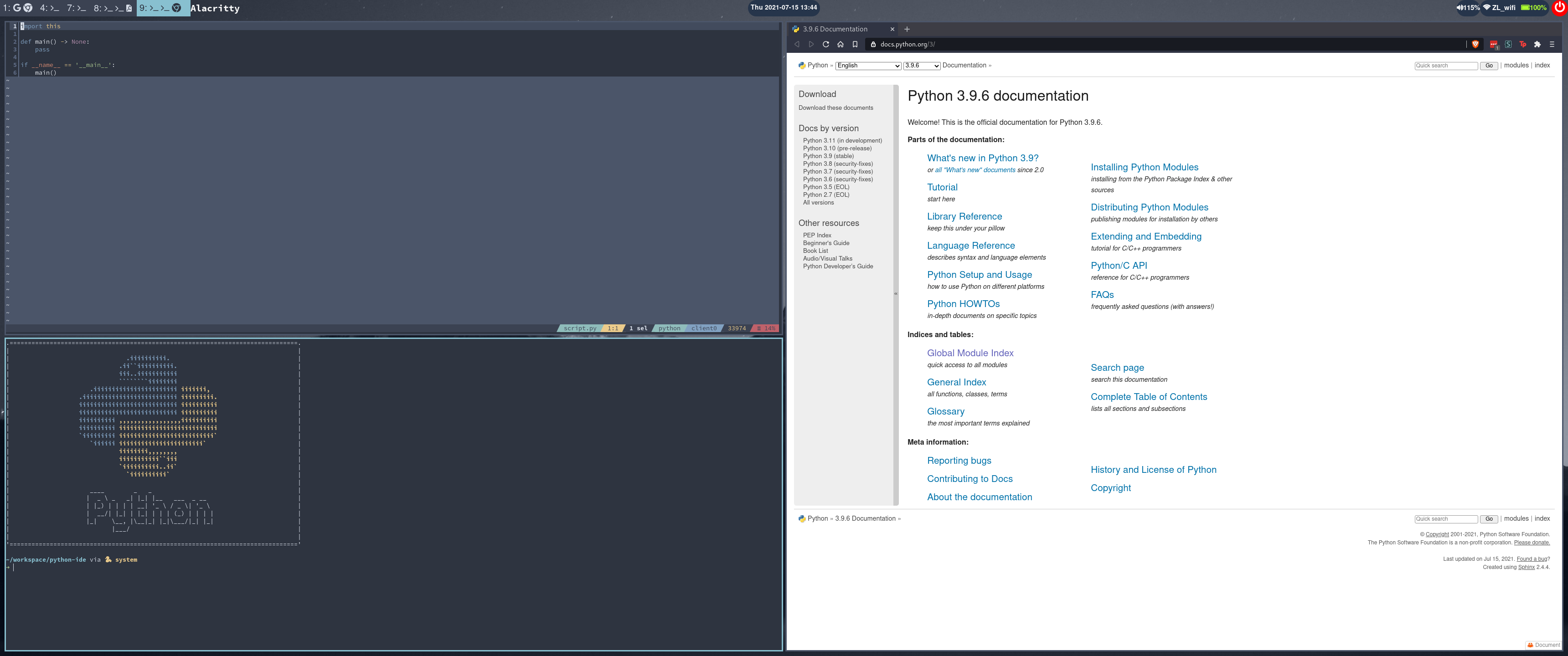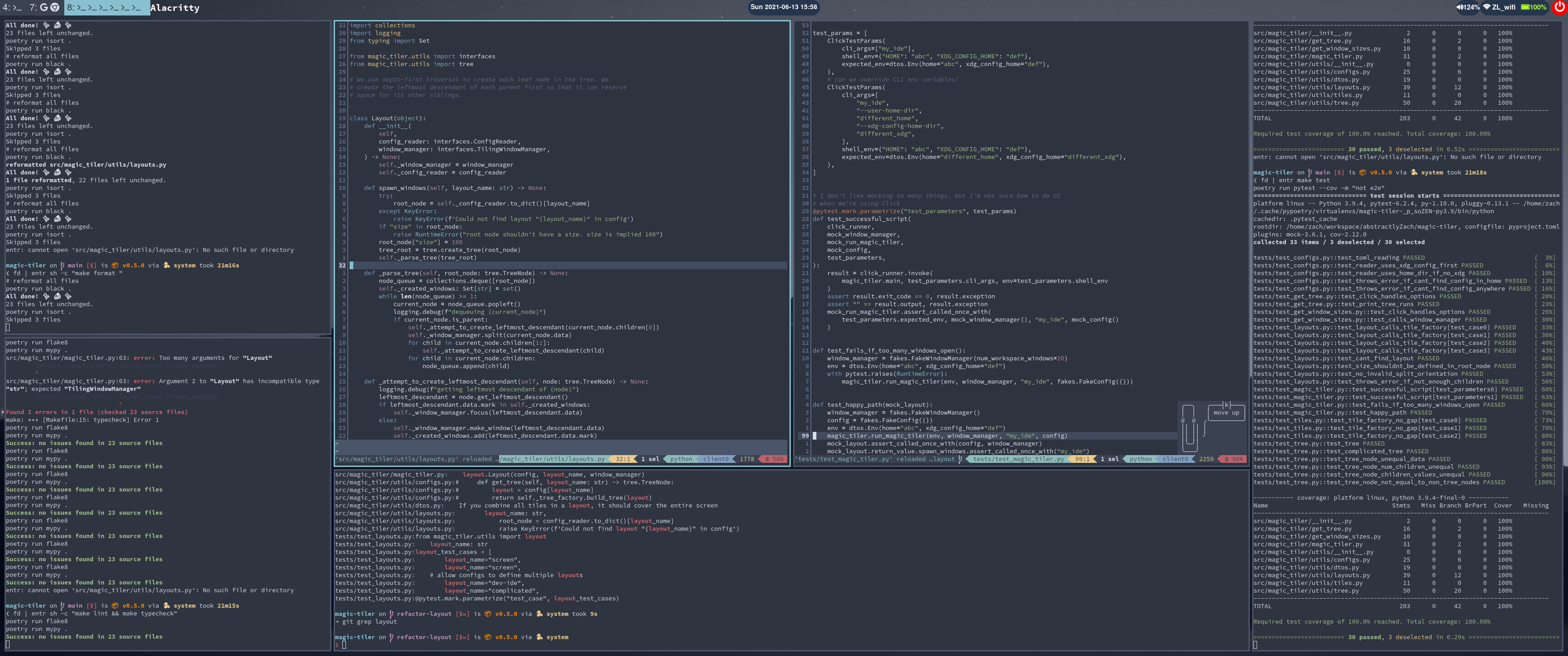reZIDE
a comfy custom IDE where you can feel right at home
Use simple, declarative configuration files to create complex IDEs with a single command!
What's it like?
Think of it like any available IDE, except:
- You can read and write your configurations easily in TOML format
- You can use any program that you prefer without waiting for anyone else to add a plugin/integration. If you can run it on your command line, you can run it in
reZIDE! Editors, linters, autoformatters, typecheckers, ASCII movies, distracting videos, etc... - You can share your configurations with others
- You can copy/learn from others' configurations
Or think of it like tmux, except:
- You don't need to learn new movement commands (use the commands that you already use for your window manager)
- You aren't restricted to applications with a Terminal User Interface (you can open web browsers, pdf previews, video players, etc.)
What's it stand for?
⬅️⬅️(Zach's)
⬇️ really
⬇️ enjoyable
➡️➡️ Z
Integrated
Development
Environment
Because that's how acronyms work.
Credits to @hyangda for brainstorming this great name with me ?
Screencap
(insert cool screencap here)
(this one's just a placeholder)
Requirements
One of these tiling window managers:
- [x] sway
- [ ] i3 (it should work out of the box, but I'm too lazy to install i3 just to test this. if you can confirm on my behalf, please check this box and submit a PR!)
At least 1 configuration file
See examples.
Installation
I recommend using pipx for environment isolation:
pipx install reZIDE
You can also use pip if you don't mind modifying your system Python environment:
pip install reZIDE
How to use
Run this command for documentation on how to use reZIDE:
rzd --help
Motivation
Tiling window managers are powerful and flexible and I love using them. However, I kept finding myself running into one issue: I'm lazy.
Whenever I sit down to work, I usually want to open a group of 2+ windows. Each window takes 5s-30s to get to a useful state. That's way too much effort. I couldn't be bothered.
Here are some groups of windows (AKA layouts) that I commonly use:
python mode
- editor for source code
- editor for tests
- browser for documentation/tickets
- terminal for arbitrary commands like linting, running tests, and installing packages
web dev mode
- editor for source code
- editor for tests
- small terminal running linter
- small terminal using a filewatcher to run tests
- small terminal running the typescript compiler
- medium terminal for running arbitrary commands
documentation mode
- editor for document
- browser/pager for source material
- terminal for compiling document into pdf
- pdf viewer for viewing compiled pdf
It usually takes at least 10 keystrokes to run a command (even with tab-completion and fuzzy-finding) and then another 5-15 keystrokes to resize the window so that it's as big or small as I want. Here's an example:
Spawning and resizing a single window
<super-enter>to open a terminal- cdd to
cdbut with fuzzy-finding - type
rezto get~/workspace/abstractlyZach/reZIDE/to show up as the first result <enter>fd | entr make typecheck<enter>to automatically run my typechecker whenever files change<super-r>to enter "resize" modeleft x5to make the window smaller<esc>to exit "resize" mode
And then I have to do that like 5 more times; that's too much work! ? I'm losing seconds of productivity every day just opening, commanding, and resizing windows!
Goals
- use only i3/sway to manage windows
- create a DIY IDE with a single command
- allow different IDEs to be defined through a readable file (like TOML)
- run arbitrary commands (not just shells and TUIs!)
Defining an IDE in TOML
Basic Python IDE
This Python IDE has a relatively basic TOML file. Here's what the final product looks like:

# python IDE
[python]
# tells reZIDE that this is a layout and it should construct a tree out of it and its descendants
is_layout = true
# this is what % of the screen each child should take up
# in this case, it's a 50-50 split
sizes = [50, 50]
# tells reZIDE the names of the Windows and Sections that belong in the "python" Section
# reZIDE will look up these Window and Section definitions elsewhere in this file and
# build them appropriately
# so here, we have terminals on the left side and documentation on the right side
children = ['terminals', 'documentation']
# the screen should be split horizontally so that the children are to the left and right
# of each other
split = "horizontal"
[terminals]
sizes = [50, 50]
children = ['python-editor', 'python-gutter']
split = 'vertical'
# our first Window definition
[python-gutter]
# run this command to:
# * spawn an alacritty window
# * set the working directory to ~/workspace/python-ide/
# * print some ascii art onto the terminal
# * start a zsh interactive shell
command = """
alacritty \
--working-directory ~/workspace/python-ide/ \
-e sh -c 'cat python.logo.colored.asciiart; zsh'
"""
# mark this window in the window manager as 'python-gutter'
mark = 'python-gutter'
[python-editor]
command = """
alacritty \
--working-directory ~/workspace/python-ide/ \
-e sh -c 'cp script_template.py script.py; kak script.py; zsh'
"""
mark = 'python-editor'
[documentation]
command = "brave --new-window https://docs.python.org/3/"
mark = 'documentation'
A complexer IDE
This IDE gives us everything we need to have a smooth development session when working on the reZIDE project.
Try opening the screenshot in another tab/window and see if you can match all of the Window/Section definitions in the TOML file to their corresponding areas on the screenshot!

# more-complicated IDE for developing the reZIDE source code
[rezide-ide]
is_layout = true
split = "horizontal"
children = ['linters', 'main', 'tests']
sizes = [20, 60, 20]
# 1st level
# ---------------------------------------------------------------------------------------
[linters]
split = "vertical"
sizes = [50, 50]
children = ['formatting', 'typechecking']
[main]
split = "vertical"
children = ['editors', 'gutter']
sizes = [70, 30]
[tests]
command = """
alacritty \
--working-directory ~/workspace/abstractlyZach/reZIDE/ \
-e sh -c 'fd | entr make test; zsh'
"""
mark = "tests"
# 2nd level
# ---------------------------------------------------------------------------------------
[formatting]
command = """
alacritty \
--working-directory ~/workspace/abstractlyZach/reZIDE/ \
-e sh -c \
'fd | entr sh -c \"echo && make format && make lint && echo_success\"; zsh'
"""
mark = "formatting"
[typechecking]
command = """
alacritty \
--working-directory ~/workspace/abstractlyZach/reZIDE/ \
-e sh -c 'fd | entr make typecheck; zsh'
"""
mark = "typechecking"
[editors]
sizes = [50, 50]
children = ['left-editor', 'right-editor']
split = "horizontal"
[gutter]
command = """
alacritty \
--working-directory ~/workspace/abstractlyZach/reZIDE/ \
-e sh -c 'neofetch; zsh'
"""
mark = "gutter"
# 3rd level
# ---------------------------------------------------------------------------------------
[left-editor]
command = """
alacritty \
--working-directory ~/workspace/abstractlyZach/reZIDE/ \
-e sh -c 'kak src/rezide/rezide.py'
"""
mark = "left-editor"
[right-editor]
command = """
alacritty \
--working-directory ~/workspace/abstractlyZach/reZIDE/ \
-e sh -c 'kak README.md'
"""
mark = "right-editor"
Shell Completion
Setting up completion for your shell
Alternatives
- tmux
- anything by jetbrains lul





